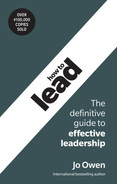part 5

Skills of success: the twenty-first-
century leader
Introduction
It is now clear that we are in the middle of a leadership revolution. Leading in the twenty-first century is unlike leading in the twentieth century. The revolution is only marginally about technology. It is much more about the changing nature of work. The pandemic and the rise of remote working have not caused the revolution, but they have accelerated it greatly.
The heart of the leadership revolution is the end of command and control. In the past, leaders made things happen through people they controlled. Now you have to make things happen through people you do not control or people who do not want to be controlled. That loss of strong form control changes everything for leaders. The pandemic accelerated this control challenge. If professionals in the office do not want to be controlled, it is even harder to control them when you cannot see them or hear them for most of the day. Command and control are tough when you do not even know if your team are wearing trousers.
There are four underlying drivers of the leadership revolution:
- •Professionalisation of the workforce: education levels are at record levels – workers can do more, but they demand more. The old paradigm was that the bosses had the brains and the workers had the hands. That is clearly no longer true. As a leader, you cannot demand loyalty; you have to earn it.
- •Employee choice: lifetime employment is over. The paternalistic firm and one-firm town are consigned to history. Firms may demand passion and loyalty, but they do not show it. Employees now have choice: if they do not like working for one firm or boss, they can find another firm or boss. Leaders have lost their coercive power. You have to rely on influence and persuasion.
- •Globalisation and specialisation: in the past, firms were like medieval walled cities that had everything they needed to sustain themselves. But with globalisation has come specialisation. Firms focus just on those things they can do best, and they outsource the rest. This is efficient, but it means that, as a leader, you now depend on partners, suppliers and channels that you do not control.
- •The lean matrix: the old days of the functionally organised pyramid are gone. We all work in some form of matrix where we depend on colleagues for our success. Success is built on influence, persuasion, trust and, occasionally, fighting battles.
The result is that the nature of leadership is changing. You are unlikely to have a steady career with one firm, where you assume increasing power as you are promoted. Instead, you will have to do the following:
- •Manage your own career as you move from one firm to the next, or set up your own.
- •Learn and refresh your core skills to stay relevant.
- •Replace command and control skills with an ability to influence, persuade and build networks of influence and trust.
- •Replace deep technical skills, which become dated or are replaced with artificial intelligence (AI), with people and political skills.
- •Be comfortable with ambiguity, change and challenge, which neither technology nor traditional managers cope with well.
- •Learn how to lead highly skilled professionals who do not want to be managed.
Twenty-first-century leadership is far more challenging than leadership in the past: it is also far more rewarding. This section shows how you can step up to the twenty-first-century challenge.
